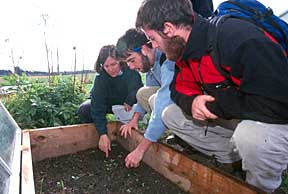 Environmental
Studies: New Major, Real-World Research
Environmental
Studies: New Major, Real-World Research
When St. Lawrence announced it would spend $2 million over the next
several years to renovate and refurbish student residential spaces,
Brian Banton '00 and Michael Newton '00 saw an opportunity to make
a difference at the University through their academic work.
 What's
the connection? Professor of Environmental Studies Alan Schwartz's
spring seminar, where students research options for making life at
St. Lawrence more environmentally friendly.
What's
the connection? Professor of Environmental Studies Alan Schwartz's
spring seminar, where students research options for making life at
St. Lawrence more environmentally friendly.
Schwartz notes that this type of "real-world" research
has been a hallmark of the environmental studies program since its
beginning in the 1970s as a combined interdisciplinary major. This
fall, the program became a separate, stand-alone department, meaning
that students may now major in environmental studies without combining
it with a major from another department, although the combined major
option with anthropology, biology, chemistry, economics, English (also
new), geology, government, philosophy, psychology or sociology continues.
Banton and Newton had participated in a study undertaken
by the seminar on the types of paper used in campus copy machines
that resulted in the University making a deal with a supplier to buy
paper with a higher post-consumer recycled content. (Read
more about that project here.) When they found out about the dorm
renovation project, they proposed researching interior paints, an
idea embraced by Director of Facilities Operations Claude Banker.
"I thought it was a great idea," Banker says. "I was
more than happy to have them research this for us, and impressed by
their professional approach to the project."
Both students researched paints to determine if the
University could use products that would be less harmful to both the
health of painters and building inhabitants and to the environment.
They looked into the content of volatile organic compounds (VOCs),
as well as a list of toxic organic and inorganic substances in a variety
of products.
Their report included recommendations of several products,
which Banker says paint crews experimented with. One aspect of using
lower VOC products, he notes, is that they generally have fewer problems
associated with odors and fumes, meaning that there is less disruption
of work in buildings while painting is under way.
Cost of the recommended product was approximately 50
cents to $1 more per gallon, Banker says, but paint crews reported
that it worked well in their tests. Over the summer, some 600 rooms
on campus were painted with the product, including 400 in Dean-Eaton.
"From now on, that's the product we'll be using on campus
to paint," Banker says. "I'm very grateful to the students for doing
the research on this. I think it's terrific."
"My students have been very motivated and excited,"
Schwartz commented, "knowing that their research might have real consequences."
--Macreena Doyle